Using Me-Me-Ha-Me-Fo-Sty-Co method:
Me-Ma-Ha-Me-Fo-Sty-Co is an acronym which is used in IB music to help remember how to analyze music.
The acronym has 6 parts, which are:
- Medium - Instrumentation and voicing
-
Melody - The main musical idea of a piece
-
Harmony - The composition of sounds
-
Meter/Rhythm - How the music flows
-
Form - Structure of the music
-
Style - Conventions of the genre
- Context - Historical and geographical background
Medium - instrumentation and voicing
Questions to ask
- What instruments are being played?
- Where are they being played?
- How thick is the voicing? Why might it be this way?
- What role does each serve (melody, countermelody, harmony, bass line, percussion)?
- What timbre does each have?
Classification of mediums
- Instruments:
- air/wind---aerophones (clarinet, trumpet, etc)
- vibrating strings---chordophones (violin, cello)
- striking membrane---membranophones (drums)
- striking material---idiophones (shaker, clave)
- body percussion---corpophones (clap, snap)
- Electrical---electrophones (synth, midi)
- Voice parts (high to low):
- Female:
- Soprano
- Alto (choir)/mezzo soprano (opera)
- Contralto (opera)
- Male:
- Male in falsetto = countertenor
- Tenor
- Baritone
- Bass
Melody - main musical ideas
Questions to ask
- What is the range---distance from highest to lowest pitch---of the melody?
- How long are melodic phrases?
- Any recurring motifs/melodic ideas?
- What is the shape of the melody? (step-wise/arpeggiated; descending/ascending; conjunct/disjunct)
- What is the countermelody, if there is one? Answer the same questions about it!
Harmony - chordal movement
Basic Vocab
- Tonic---The harmonic base/center for a scale, most commonly the first note
- Chord---3 or more notes played at the same time
- Consonance---harmonic stability, resolution
- Dissonance---harmonic instability, lack of resolution, "crunch"
- Diatonic---within the key
- Chromatic---outside the key
Triads
There are many different ways to think about how triads are formed. One way is by counting the intervals between each note in the triad (or stacking them, like a snowman):
- Major triad---Root, M3, m3
- Perfect 5th from top to bottom
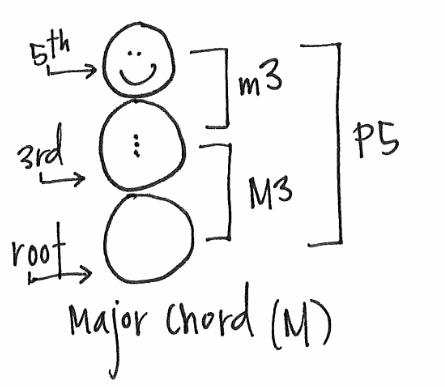
- Minor triad---Root, m3, M3
- Perfect 5th from top to bottom
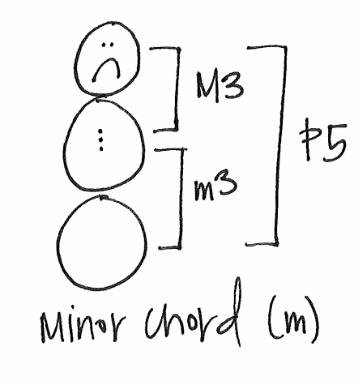
- Augmented triad---Root, M3, M3
- Augmented 5th from top to bottom (sounds like m6)
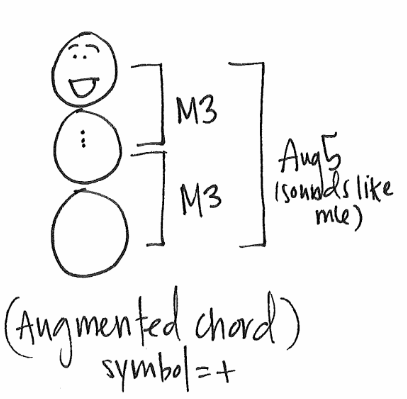
- Diminished triad---Root, m3, m3
- Diminished 5th (or a tritone) from top to bottom
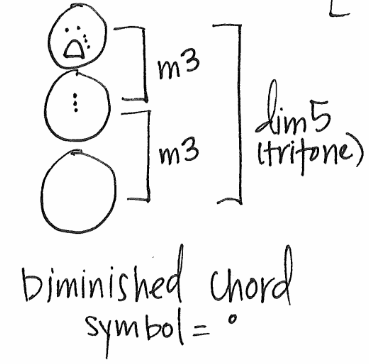
Intervals can also be thought of as how the major triad is modified:
- Major---Basis
- Minor---Flat the 3rd of the major
- Augmented---Raise the 5th of the major
- Diminished---Lower the 3rd and 5th of the major

7th chords
Chord extensions are chords with more than three tones in them. 7th chords are the most common, and there are 5 important types of them:
- Major-minor 7th/Dominant 7th---major triad with m3 on top
- Maj7---major triad with a M3 on top
- Minor 7th---minor triad with m3 on top
- Diminished---diminished triad with m3 on top
- Half-diminished---diminished triad with M3 on top

Other chord extensions include 9ths, 11ths, and 13ths, but they are most common to jazz.
Inversions:
The base of a chord does not have to be the same as the root. Root = the note the chord is based on; base = the lowest note of the chord. Sometimes, the root and the base are the same, but when it's not, the chord is called an inversion.
For example, a C maj chord can be spelled E, C, G, and still be considered a C major chord. What it is is an inversion, or a chord where the root is not the lowest note.
There are 4 different types of inversions (usually):
- Root position---root is the lowest, the base. Can be separated by octaves.
- 1st inversion---3rd of the chord is the base
- 2nd inversion---5th of the chord is the base
- 3rd inversion---Only implies when the chord has a 7th, when the 7th is in the base
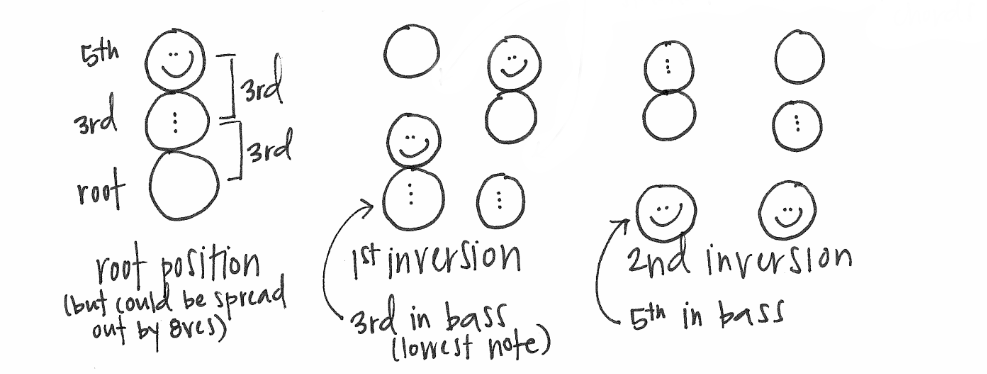
Root, 1st, and 2nd inversions can have 7ths on top
Bass Position Symbols (BPS)---Used during roman numeral analysis to tell what inversion a chord is in. Also known as figured bass during the Baroque era. Notation is as follows:
For triads:
- Root position---V
- 1st inversion---V6
- 2nd inversion---V6/4
For 7ths:
- Root---V7
- 1st inversion---V6/5
- 2nd inversion---V4/3
- 3rd inversion---V4/2
Diatonic triads
Diatonic triads are the triads within the key/scale. In a scale, these chords are classified by whether they are major, minor, or diminished. Major chords are notated by capital roman numerals (I, V, etc), minor chords with lower case roman numerals (ii, iii, etc), and diminished with lower case as well, notated with a o (viio).
In a major scale, the diatonic triads are as follows:
- Major: I, IV, and V
- Minor: ii, iii, and vi
- Diminished: viio
In a natural minor scale, they are:
- Major: III, VI, VII
- Minor: i, iv, v
- Diminished: iio
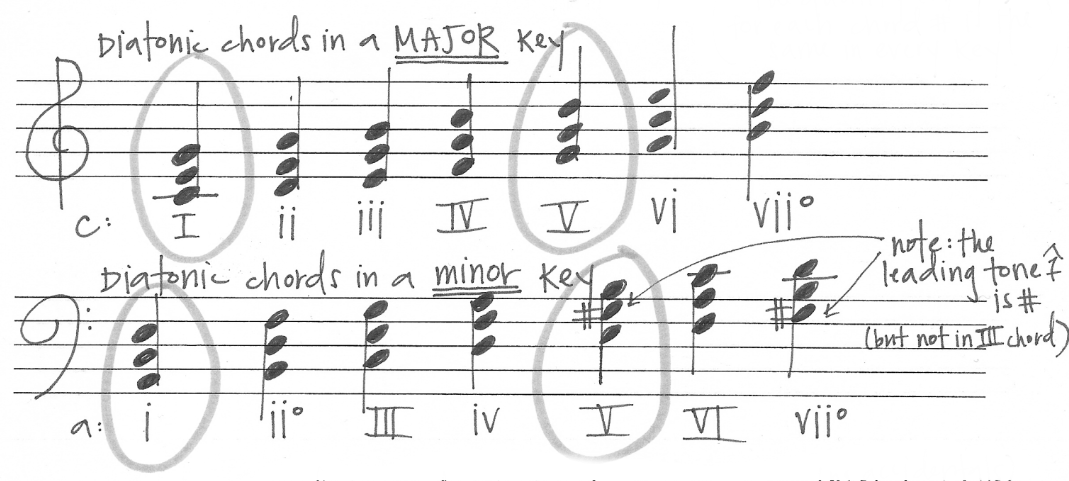
Note: V and vii are often modified to remain major and diminished, respectively, to keep the pull to the i chord. This is why the melodic and harmonic minor scales are sometimes used, as they keep that pull in place.
Functional Harmony
As mentioned above, the minor scale is often modified to keep the pull to the i chord. This is because, in Western harmony, certain chords play certain roles. The V and the viio often serve to lead into or resolve to the I, while the v and VII do not. This is called functional harmony, as each chord has a function within the scale.
There are three common roles chords can serve: subdominant, dominant, and tonic. The subdominant resolves to the dominant, the dominant resolves to the tonic, and the tonic serves as the home base, the resting point for the harmonic motion. Using roman numeral analysis, chordal motion in a major key is described below:
- I---tonic, goes wherever it wants
- V and viio---dominant, go to I
- IV and ii---subdominant, go to V and viio
- IV can also go to ii or I (see cadences below)
- vi, iii---kind of ambiguous in terms of function, though not directionless
- vi goes to IV, ii, or vi
- iii goes to IV

Cadences
A cadence serves as musical punctuation, a sign that a section is done. There are 5 main types to be aware of:
- Authentic cadence---V-I
- Perfect authentic cadence---root position V-I, top note is tonic
- Imperfect authentic cadence---doesn't meet one of the qualifiers for perfect authentic, but still follows V-I

- Deceptive cadence---V-vi or V-anything that isn't I/i. Sounds like it will be authentic, but it's not
- Half cadence---ends on V
- Plagal cadence---"amen" cadence, often used in mass. IV-I
-
Meter/Rhythm
How to identify the meter of a piece
- Bottom number: How many beats are in each measure?
- Can be duple (2 beats), triple (3 beats), or quadruple (4 beats)
- Top number: How many subdivisions occur in each beat?
- Simple meter---beat is divided in 2 (sounds like eighth notes)
- If so, top number is usually 2, 3, or, 4
- Compound meter---beat is divided in 3 (sounds like triplets)
- If so, top number is usually 6, 9, or 12
- Example: 4/4 time is simple quadruple---4 beats per measure, subdivision is 2
- Meter can also be asymmetrical, where the meter can not be divided into equal beats (like 5/8, 7/8, etc)
Questions to ask
- What is the time signature (see above)?
- Does the time signature change? Where? To what?
- What is the tempo? Does it change?
- How long are phrases?
- Any common rhythmic motifs?
- Any ornamentation? (trills, arpeggios, grace notes, scales)
Form - Structure and development
Common forms:
- Binary---AB
- Rounded binary---ABA′ where A′ is 1/2 of A
- Ternary---ABA1 where A1 is similar to A, but different enough to be distinct
- Strophic---A1,A2, A3... repeated tune with different words
- Through composed---A, B, C, D... each section is different
- Sonata-allegro form---
- A: exposition, introduce 2 melodic themes (1st in I, 2nd in V)
- B: development, expands themes. Melodic center unstable, plays with themes
- C: recapitulation, returns. Comes back to the melodic themes and gives them final conclusions
- (More elaboration on this form in the Classical Era section)
- Rondo---A, B, A, C, A... Alternating A sections
Style - Character and genre
Certain stylistic elements can place a piece in a particular genre/era---Easiest to look at is texture
Classification of texture:
- Monophonic---single, unison melodic line
- Homophonic---melody and accompaniment
- Polyphonic---2 or more melodies happening at the same time
- Heterophonic---unison line with slight improv/variations at the same time (monophonic, but not completely uniform)
- Biphonic---2 lines, one is melody and one is the drone
One piece can include more than one type of texture, like Scherzo from Schubert’s piano sonata in B major D575.
Context
Questions to ask:
- Who?---Who were the performers, audience, composers, arrangers, recording engineers, etc?
- What?---What's the genre (symphony, dance quite, fugue, art song, etc)? Is it notated or improvised?
- Where?---Where is it from? Where was it performed?
- When?---When was the music written? Was there a specific era? Was it common or unconventional at the time?
- Why?---Why was it composed (entertainment, religion, etc.)? Why was it performed?
Editors- allisonmustync - 3040 words.
- joeClinton - 62 words.
View count: 14334